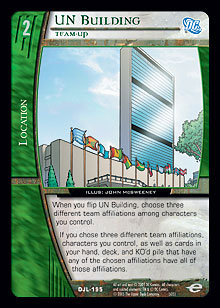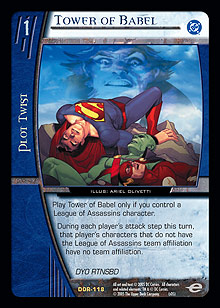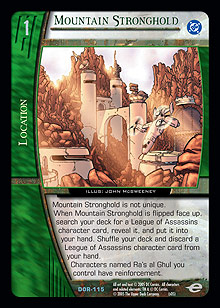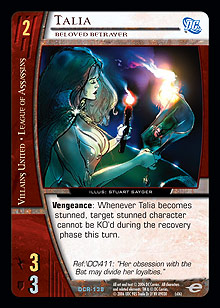I can’t believe I’m actually doing this.
At least I know who to blame: Ian Vincent. He chirped up on the Deck Clinic submissions thread over on VSRealms.com with the following thought:
“Any chance of a clinic on the infamous Big Deck format? It’d be really interesting to see what kind of strategy you can come up with for it.
DTee”
My reply was (as far as I am concerned) incredibly restrained. I only went so far as to pull a face and call him a sadist, but it did at least inspire me to take a look at the rules of the format, which was created by Pro Circuit Champion Adam Prosak. (Rules reprinted here courtesy of VsRealms.com.)
The One Big Deck Format
 The rules of the format are simple:
The rules of the format are simple:
- Your deck must contain at least 100 cards, including one copy of UN Building.
- You cannot play more than one copy of any card.
- You must play at least four different team affiliations and at least ten characters from each of the four affiliations.
- At the beginning of each game, after resolving mulligans, you can put your UN Building into your hand. Effectively, you will start with a five-card hand that contains a UN Building.
- The more EA cards in your deck, the better. The more scribbled-on cards in your deck, the better.
Many of these decks resemble the power level of a sixty-card Sealed deck built from fifteen packs, and occupy that awkward space between Sealed decks and Constructed powerhouses. The best 100-card decks could likely compete at a Hobby League level, if you were so inclined.
Now, if that sounds like a bit of a headache for a Clinic, you’d be right. Unfortunately, without even realizing it, Ian had hit me right in a weak spot. I’m a total sucker for things like this.
Now, the question is what to build. Do I simply mash my four favorite teams together and try to make them work? (For reference, that would probably be the League of Assassins, Checkmate, Brotherhood, and either Anti-Matter, Underworld, or Doom.) Or do I choose a strategy first, and then find the best teams to suit? The latter sounds likely to be both more successful and more interesting, so I’ll run with it.
Here are a few of my first thoughts as I try to get my head around the format:
 1) Team affiliations. Specifically, how much I like taking them away from other people. Tower of Babel is probably in my top three cards of all time.
1) Team affiliations. Specifically, how much I like taking them away from other people. Tower of Babel is probably in my top three cards of all time.
2) For some reason, I like using locations. I’m not entirely sure why (probably something I picked up while playing League because of reason 1).
3) I like cards like Insignificant Threat that let me stomp all over tiny people that try to gang up on me.
4) I like large, beefy characters. I like Ahmed Samsarras; I like Maxwell Lords; I like Deathwatches; I like Heavy Hitters.
5) If it makes sense for any given format, I lean toward playing relatively conventional curve decks. This doesn’t mean I always will—I’ve spent many a happy afternoon merrily recruiting Shadow Creatures and turning them sideways to Qward irritating willpower weenies. I just have a preference.
So, Tower of Babel, Insignificant Threat, Ahmed Samsarra . . . What, you didn’t think I was going to avoid my favorite teams completely, did you? I like those teams because they fit the strategies I enjoy playing, after all. But sometimes, those strategies just aren’t good enough for a particular tournament.
If I start from a baseline of League of Assassins, Checkmate, and Brotherhood, then what’s the fourth team going to be? I decided to do a quick scan-through, looking in particular for teams that could help out with the affiliation-removing piece of the puzzle. Of course, getting Reign of Terra into my opponent’s resource row somehow would be really awesome, but that one seems a little unlikely.
So, what did I find? The Future Foes have Ra’s al Ghul, Engine of Change and Return of the Demon’s Head, which can both remove team affiliations if your opponent is unable to discard. Ra’s is even dual-affiliated with League of Assassins! The Masters of Evil and Kang each have a single appropriate card: Helmut Zemo ◊ Baron Zemo, Über Enemy can remove team affiliations from defenders (but only on turn 7 and only as a leader power), while Spheres of Solitude can act like a miniature, permanent Tower of Babel. Not a lot to work with, really. The Future Foes cards look appealing, but with a 100-card deck, it will be very difficult to apply consistent pressure to our opponent’s hand size. That difficulty will compromise our ability to get Ra’s and Return of the Demon’s Head to work.
In the end, I decided to go with a team that provided dual-affiliated characters that crossed into one of my definite teams, a selection of powerful characters, and a few ways to help keep safe from harm the inevitable Ahmed Samsarra that I am unable to resist. Step forward, Villains United. The Science Spire is obviously a powerful card, but other “return to hand” costs like that of Baddest of the Bad and Grand Gesture provide some extra King insurance. Coercion as an extra Team-Up will also be very welcome, allowing team-stamped plot twists like Insignificant Threat or Tower of Babel to appear out of nowhere.
The deck will be predominantly a curve deck that aims to drag the game into the later turns by controlling the board, preventing team-attacking, punishing attempts to attack up the curve, and possibly using KO effects to further break down the opponent.
 Normally I’d plunge straight into character selection at this point in the deckbuilding process, but given the unique nature of the format, there’s something I want to do first. I want to work out what search cards I actually have available, given the restriction to a single copy of each.
Normally I’d plunge straight into character selection at this point in the deckbuilding process, but given the unique nature of the format, there’s something I want to do first. I want to work out what search cards I actually have available, given the restriction to a single copy of each.
Mountain Stronghold
Brother I Satellite
Straight to the Grave
Sovereign Superior
Rise to Power
Weapon of Choice
Mobilize
Secret Origins
Vicarious Living
Baddest of the Bad
Connie Webb, Knight
Alexander Luthor, Duplicitous Doppelganger
There are twelve cards there, and it’s not even guaranteed that all of those will make the deck. Even playing cards that I normally wouldn’t in a sixty-card deck (Secret Origins, for example, depends too much on your opponent cooperating for my liking, while Weapon of Choice will never get the character you want and packs a hefty double discard cost), the deck will be a lot lighter on character search than a regular Constructed deck. This isn’t a bad thing, it’s simply a feature of the format. As far as I’m concerned, deckbuilding rules—particularly for casual formats—are never really good or bad, just more or less restrictive. As long as the rules of the format allow for a good variety of different, interesting strategies, and the bare minimum of search cards needed to allow decks other than “random bunch of big characters” to behave predictably enough to be worthwhile, it’s all good.
Given my inexperience with the format, I turned to my trusty spreadsheet to work out what sort of character numbers I’d need to run to make the Big Deck tick. I worked on the assumption that the 3-drop would be the first really critical drop; 2-drops are nice, but 3-drops are usually essential. I decided that mulliganing for a 3-drop would be the working assumption. I’m not going to go through all the calculations, because honestly, this is going to be long enough without them. Would you rather read number-crunching or discussion of actual cards?
The search cards above point to two “skeletons” that I want running through my deck. By skeleton, I mean a curve within a curve that fits a particular characteristic—in this case, character cards with vengeance (Alexander Luthor, Duplicitous Double) and character cards with reservist (Sovereign Superior). I would like to be able to search for a character at any point on the curve with either of these cards, as this means that I can always keep an opening hand with Luthor or Sovereign, and a Brotherhood character. It also means that I can always guarantee hitting my next drop with an underdropped character and Luthor.
Right, then—let’s start trawling through the available characters! (Please note that given the sheer number of cards involved in the deck, this week’s Deck Clinic is being split into three parts. Look for the rest of the character discussion tomorrow.)
1-drops
The first inclusions here are Connie Webb, Knight and Alexander Luthor, Duplicitous Doppelganger, our two searching 1-drops. The Calculator, Noah Kuttler will be included for his ability to search for Coercion. The other inclusions will be another pair of utility cards: Mikado and Mosha, Angels of Destruction, with a possible on Mr. Mxyzptlk, Troublesome Trickster. Given that I won’t be mulliganing for them, I’m not keen to run more non-search 1-drops that actually need to be recruited.
2-drops
 First, the reservist options. On-team, we have Chrome, Acolyte with a not-so-exciting power and a solid 3 ATK, and Amelia Voght, Acolyte with an equally unexciting power and less aggressive stats. Chrome seems like the pick. Off-team, the options of interest are Adam Strange, Champion of Rann as a pseudo-plot twist and Natasha Romanoff ◊ Black Widow, Super Spy as a character that can help us reach hidden characters at the cost of teaming-up with Avengers.
First, the reservist options. On-team, we have Chrome, Acolyte with a not-so-exciting power and a solid 3 ATK, and Amelia Voght, Acolyte with an equally unexciting power and less aggressive stats. Chrome seems like the pick. Off-team, the options of interest are Adam Strange, Champion of Rann as a pseudo-plot twist and Natasha Romanoff ◊ Black Widow, Super Spy as a character that can help us reach hidden characters at the cost of teaming-up with Avengers.
The vengeance options fit better with our teams. Talia, Beloved Betrayer is a personal favorite, and Dr. Psycho, Mental Giant has a great ATK value and a useful power against off-curve strategies. Ragman, Patchmonger gives us an off-team drop that can get bigger and bigger while disrupting our opponent’s KO’d pile, while Peter Merkel ◊ Ragdoll, Malleable Miscreant provides a Slaughter Swamp–style effect on an evasion body.
For general 2-drops, these are the characters from each team that I consider most interesting, in order of preference from highest to lowest:
League of Assassins
Talia, Beloved Daughter – She can search for either of two 4-drops, a 5-drop, a 6-drop, or an 8-drop.
Talia, Daughter of the Demon’s Head – Any card-filtering is welcome given the size of the deck involved.
Bronze Tiger, Benjamin Turner – He’s small on turn 2, but increases in power as the game goes on and gives your opponent trouble ordering attacks.
Hassim, Loyal Retainer – He’s small, but with a useful +ATK power.
Checkmate
Sarge Steel, Knight – Does any more need to be said about Sarge? Director Bones, D.E.O. – A little small, but he has concealed and a really nice backup power.
Black Thorn, Elizabeth Thorne – Nice ATK, nice activated power, but painful loyalty—reveal.
Sasha Bordeaux, Knight – 3 ATK, but weak powers for this deck.
Villains United
The vengeance characters already discussed should be fine for Villains United.
Brotherhood
Crimson Commando, Freedom Force – He has a great ATK, and a power that isn’t impossible to trigger.
Toad, Mortimer Toynbee – He has 3 ATK and returns to your hand if he would be stunned.
Destiny, Future Sight – Card drawing is very attractive.
I’m afraid that’s going to have to be all for today. Check back tomorrow, when I’ll be going through the rest of the character options and starting the always-painful process of cutting down to a sensible character total. I’ll be cutting down to more like fifty-five or sixty characters this time, but does that mean it won’t hurt?
Tom Reeve is a member of the Anglo-Canadian Alliance (like the Rebel Alliance, but with public transport instead of X-Wings) and would-be professional layabout from London, England. While his love of all things ninja has resulted in an arguably unhealthy affinity for the League of Assassins, that particular quirk turned into a healthy plus with the birth of the Silver Age deck Deep Green, with which teammate Ian Vincent took home the Pro Circuit San Francisco trophy to dear old Blighty.